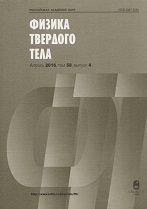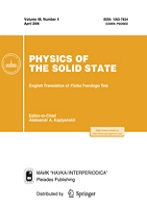|
This article is cited in 3 scientific papers (total in 3 papers)
Polymers
Unoccupied electron states and the formation of interface between films of dimethyl-substituted thiophene–phenylene coolygomers and oxidized silicon surface
A. S. Komolova, E. F. Laznevaa, N. B. Gerasimovaa, Yu. A. Paninaa, G. D. Zashikhina, S. A. Pshenichnyukb, O. V. Borshchevc, S. A. Ponomarenkocd, B. Handkee
a Saint Petersburg State University
b Institute of Molecule and Crystal Physics, Ufa Federal Research Centre, Russian Academy of Sciences
c N. S. Enikolopov Institute of Synthetic Polymer Materials RAS, Moscow
d Lomonosov Moscow State University
e GH University of Science and Technology, Faculty of Material Science and Ceramics, Kraków, Poland
Abstract:
The unoccupied electron states and the boundary potential barrier during deposition of ultrathin films of dimethyl-substituted thiophene–phenylene coolygomers of the type of CH$_3$–phenylene–thiophene–thiophene–phenylene–CH$_3$ (CH$_3$–PTTP–CH$_3$) on an oxidized silicon surface have been studied. The electronic characteristics have been measured in the energy range from 5 to 20 eV above the Fermi level using total current spectroscopy (TCS). The structure of the CH$_3$–PTTP–CH$_3$ film surfaces has been studied by atomic force microscopy (AFM), and the atomic compositions of the films have been studied by X-ray photoelectron spectroscopy (XPS). The changes in the maximum intensities measured by the TCS method obtained from the deposited CH$_3$–PTTP–CH$_3$ film and from the substrate during increasing in the organic coating thickness to 6 nm is discussed. The formation of the boundary potential barrier in the $n$-Si/SiO$_2$/CH$_3$–PTTP–CH$_3$ is accompanied by the decrease in the surface work function from 4.2 $\pm$ 0.1 to 4.0 $\pm$ 0.1 eV as the organic coating thickness increases to 3 nm. The ratio of atomic concentrations C: S in the CH$_3$–PTTP–CH$_3$ films well corresponds to the chemical formula of CH$_3$–PTTP–CH$_3$ molecules. The roughness of the CH$_3$–PTTP–CH$_3$ coating surface was not higher than 10 nm on the $\sim$10 $\times$ 10 $\mu$m areas as the total CH$_3$–PTTP–CH$_3$-layer thickness was about 100 nm.
Received: 30.10.2017
Citation:
A. S. Komolov, E. F. Lazneva, N. B. Gerasimova, Yu. A. Panina, G. D. Zashikhin, S. A. Pshenichnyuk, O. V. Borshchev, S. A. Ponomarenko, B. Handke, “Unoccupied electron states and the formation of interface between films of dimethyl-substituted thiophene–phenylene coolygomers and oxidized silicon surface”, Fizika Tverdogo Tela, 60:5 (2018), 1012–1017; Phys. Solid State, 60:5 (2018), 1029–1034
Linking options:
https://www.mathnet.ru/eng/ftt9216 https://www.mathnet.ru/eng/ftt/v60/i5/p1012
|


| Statistics & downloads: |
| Abstract page: | 69 | | Full-text PDF : | 19 |
|



 Contact us:
Contact us: Terms of Use
Terms of Use
 Registration to the website
Registration to the website Logotypes
Logotypes